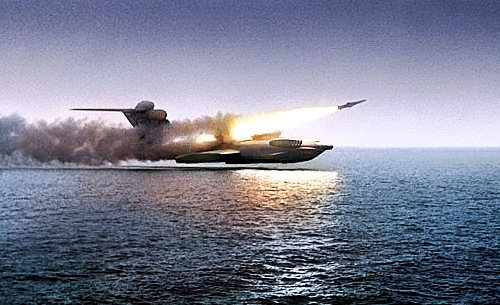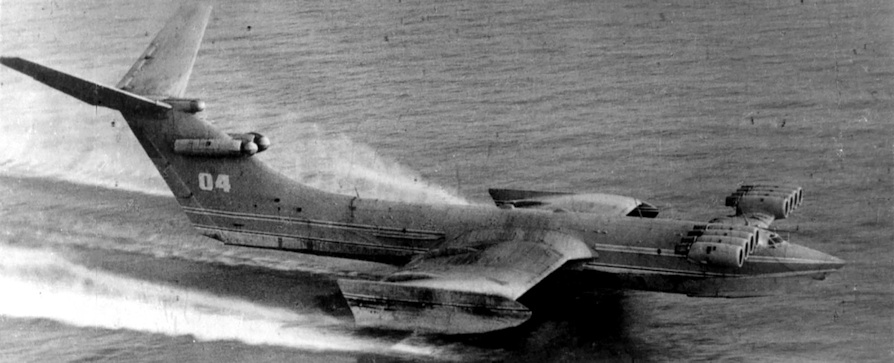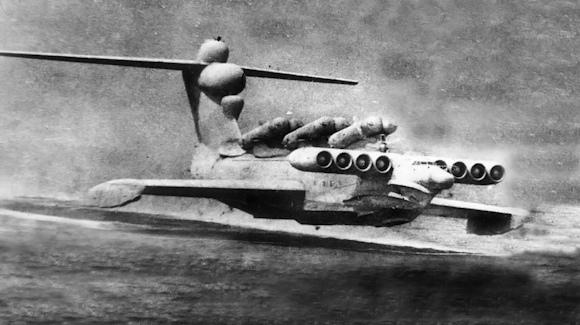During the 60s the Central Hydrofoil Design Bureau, under the direction of designer Alexeyev and chief engineer Efimov, developed the Korabl Market (bottom photo) or better known as the Monster of the Caspian Sea. KM, classified as an ecranoplane, was the largest and heaviest aircraft in the world between 1966 and 1988, surpassed only by the advent of the Antonov An-225 Mriya.
Built at the plant Red Sormov of Nizhny Novgorod between 1964 and 1966 on KM it had a wingspan of 37.6m, a length of 92m, a maximum take-off weight of 494t and was able to fly with a flight profile at a variable altitude between 5 and 10m in height, thus making it difficult to detect. by radar. Thanks to the propulsion of ten Dobrynin turbojets VD-7, the ecranoplane could fly at a cruising speed of 270 knots and carry up to 55 people at a maximum of 1500km.
Despite the KM was in effect an airplane, the Soviet authorities classified it as a ship and assigned it to the Voyenno-Morskoy Flot and was launched with the traditional breaking of the bottle, even if the tests were then conducted by experimenters pilots of the Voyenno-Vozdushnye Sily and was used as a basis for the next class Mon.
 the class Mon, also born from the pen of Alexeyev, was an ecranoplane with attack and transport tasks of smaller dimensions than the previous KM, but with greater range and speed thanks to the eight most powerful Kuznetsov engines NK-87that MD-160 (opening photo and right), the only example of the class Mon built, it was capable of carrying up to 100t of cargo with a crew of fifteen men between officers and sailors, equipped with search radar Puluchas and armed with six SS-N-22 anti-ship missiles Sunburn and two twin turrets with 23mm guns for self-defense. The MD-160 from the naval base of Kaspiysk it served the Black Sea Fleet from 1987 to the end of the 90s and from August 2020 it was transported, with an important logistical effort, to Derbent in Dagestan where it will appear inside the unborn Patriot Park.
the class Mon, also born from the pen of Alexeyev, was an ecranoplane with attack and transport tasks of smaller dimensions than the previous KM, but with greater range and speed thanks to the eight most powerful Kuznetsov engines NK-87that MD-160 (opening photo and right), the only example of the class Mon built, it was capable of carrying up to 100t of cargo with a crew of fifteen men between officers and sailors, equipped with search radar Puluchas and armed with six SS-N-22 anti-ship missiles Sunburn and two twin turrets with 23mm guns for self-defense. The MD-160 from the naval base of Kaspiysk it served the Black Sea Fleet from 1987 to the end of the 90s and from August 2020 it was transported, with an important logistical effort, to Derbent in Dagestan where it will appear inside the unborn Patriot Park.
The second one Mon, on the other hand, following the accident on 7 April 1989 to the submarine (Project 685 Plavnik) K-278 Komsomolets which caused the death of 42 sailors, was rethought for maritime search and rescue becoming the Spatel (rescuer), able to operate also as a hospital ship, or to carry up to 550 troops or a few hundred tons of cargo, even if the only existing example was blocked at 98% of construction completion by the collapse of the Soviet Union .
As reported by Focus in December 2017 it Spatel it could be reconditioned to be used in arctic operations and even the Russian military authorities would like to reconstitute the production lines to produce new models starting from 2025. The news was then also confirmed by TASS as the project falls within the budget Moscow Defense 2018-2025.
Definitely a car like it Spatel, if put back into production, it could revolutionize logistics being able to quickly transport large quantities of men and materials, even reaching bases located in the most remote areas with particular attention to the Arctic given the ambitions of the Russian Federation in those areas, but these qualities and these means could also be imitated by Beijing, using them in support of the landing departments of the People's Liberation Army Navy Marines Corps or in the connections between its mainland and the artificial atolls located in the disputed areas of the East China Sea.

Photo: web / MoD CCCP / TASS












